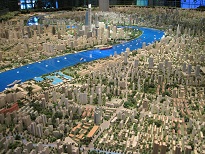- DSpace Home
- →
- Thesis and Dissertation
- →
- Master of Planning (Urban and Regional Planning)
JavaScript is disabled for your browser. Some features of this site may not work without it.
Master of Planning (Urban and Regional Planning)
Browse by

All rights reserved SPAB
Recent Submissions
-
(SPA Bhopal, 2025-05)Landslides are one of the major destructive disasters in Shimla, causing loss of life, loss of livelihood, infrastructure damage, etc. Landslides increase every year due to increasing population and human activities. As ...
-
(SPA Bhopal, 2025-05)The rapid expansion of the gig economy, particularly within the e-commerce and logistics sectors, has introduced new challenges and opportunities for urban spatial planning in India. Exploring the spatial and infrastructural ...
-
(SPA Bhopal, 2025-05)Urban areas globally are facing escalating threats from flooding, a consequence of rapid urbanization, inadequate infrastructure, and the intensifying impacts of climate change. This vulnerability is particularly pronounced ...
-
(SPA Bhopal, 2025-05)India, known for its diverse religious traditions, has been a major pilgrimage destination for Hindus, Buddhists, Jains, Sikhs, Muslims, and Christians for centuries. Pilgrimage in India is deeply rooted in spiritual ...
-
(SPA Bhopal, 2025-05)The Risk Informed Gram Panchayat Spatial Development Plan (GPSDP) for a riverine village is a strategic framework aimed at fostering sustainable, inclusive, and climate-resilient development. Riverine villages face unique ...
-
(SPA Bhopal, 2025-05)Exploring sustainable risk reduction strategies for the low-income households in Mumbai since the delayed judicial orders on resettlement for decades have been causing a degradation of the existing locality and surroundings, ...
-
(SPA Bhopal, 2025-05)The rapid expansion of commercial real estate is no longer confined to Tier 1 cities; it has also become a significant trend in Tier 2 cities. This shift is driven by economic growth, infrastructure development, changing ...
-
(SPA Bhopal, 2025-05)Green open spaces are essential for sustainable urban development, contributing to environmental, social, and economic well-being. They enhance environmental quality, promote health and safety, and foster social cohesion ...
-
(SPA Bhopal, 2025-05)The Hindon River, flowing through Ghaziabad, has witnessed rapid environmental degradation due to unplanned urbanization, industrialization and changing land use patterns. Once a natural asset supporting local livelihoods ...
-
(SPA Bhopal, 2025-05)The livelihood in an urban growth centre becomes an important point between a rural and an urban economy defining a developmental region. These growth centres emerge due to rapid urbanization which affords providing better ...
-
(SPA Bhopal, 2025-05)The rapid pace of urbanization in India has exacerbated housing affordability challenges, particularly for economically weaker sections (EWS), low-income groups (LIG), migrants, and slum dwellers. Traditional affordability ...
-
(SPA Bhopal, 2025-05)Urban transportation systems in fast-growing cities are grappling with challenges including traffic congestion, pollution and underuse of public transportation facilities. Traditional interventions, such as road-widening ...
-
(SPA Bhopal, 2025-05)As cities expand beyond their traditional boundaries, peri-urban areas emerge as dynamic spaces shaped by rapid urbanization, shifting land uses, and socioeconomic transitions. While these areas play a crucial role in urban ...
-
(SPA Bhopal, 2025-05)The rapid pace of urbanization and projected growth of India’s urban population to 600 million by 2030 have intensified the demand for accessible, efficient, and sustainable public transport systems. Cities like Jaipur are ...
-
(SPA Bhopal, 2025-05)Urban freight transport is a critical yet often overlooked component of city planning, especially in Tier-2 cities like Bhopal. As urban areas continue to grow, the demand for goods movement increases, straining infrastructure ...
-
(SPA Bhopal, 2025-05)Common-Pool Resources (CPRs), defined by rivalrous use and difficulty of exclusion, are highly vulnerable to overuse and depletion, presenting significant sustainability challenges, especially within the context of the ...
-
(SPA Bhopal, 2025-05)Communities in the Global South are at risk from climate change, with significant impacts on India's unorganised craft sector, as 200 million artisans face resource depletion, displacement, supply chain disruption by ...
-
(SPA Bhopal, 2025-05)Urban flooding has emerged a critical challenge for cities worldwide, especially in developing regions where rapid urbanization surpasses infrastructure development. This poses a significant threat to critical infrastructure, ...
-
(SPA Bhopal, 2025-05)India’s metro rail systems have emerged as transformative urban infrastructure, reshaping mobility patterns and influencing real estate development. In Tier-2 cities like Nagpur, the metro presents a timely opportunity to ...
-
Strategic planning interventions for mitigating land degradation in the eco-sensitive Aravalli hills (SPA Bhopal, 2025-05)The Aravalli Hills, among the world’s oldest mountain ranges, form a vital ecological backbone for northwestern India, stretching across Delhi, Haryana, Rajasthan, and Gujarat. They play a critical role in regulating ...